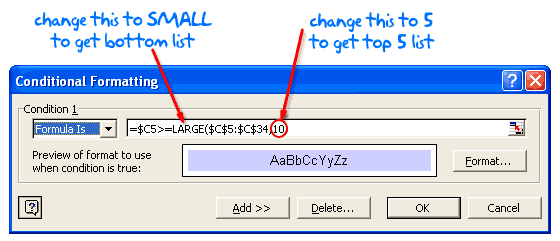 In excel conditional formatting basics article, we have learned the basics of excel conditional formatting. In this and the next 4 posts, we will learn some more nifty uses of excel conditional formatting.
In excel conditional formatting basics article, we have learned the basics of excel conditional formatting. In this and the next 4 posts, we will learn some more nifty uses of excel conditional formatting.
Let us see how we can highlight top 5 or 10 values in a list using excel as shown aside:
To do this, you need to learn the excel formula – LARGE (more on large formula)
Large formula is used to fetch the nth largest value from a range of numbers. Refer to the above link for easy to understand help on large (and SMALL too)
To highlight the top 10 values,
1. Select the range of values and launch conditional formatting dialog.
2. Assuming you have cells in the range c5: c30, In the formula we need to specify a condition that would be true only if a value is more than or equal to the top 10th value in the range c5:c30 – LARGE($C$5:$C$30,10), thus our formula will be, C5>=LARGE($C$5:$C$30,10)
3. Finally specify the formatting you want to apply. When you are done, press ok.

That is all.
If you want to highlight the entire row instead of a cell, you should use $C5 instead of C5. Why so? That is your home work. Here is a little tip on using relative vs. absolute cell references in excel.
To highlight bottom 10 in a list, all you need to do is change the formula from LARGE to SMALL.
Download the example workbook and learn how to highlight top 10 values in a range.
In the next article
We will learn how you can search a spreadsheet full of data using conditional formatting. So stay tuned and if you havent already, join our newsletter.





















3 Responses to “CP049: Don’t do data dumps!!!”
Your title got me nervous because I'm all about data dumps, but not for attaching graphics to data dumps. My reason for using data dumps is when someone is trying to do analysis and their starting point is a report that's formatted in a way for a human to read. I instruct them to stop with the report and go get a data dump: just rows and columns and rows and columns.
Agreed, nearly all of my reports start with 100+ lines of simple table data.
That way you can build your functionality around pulling information from that tabled information.
Yes yes!